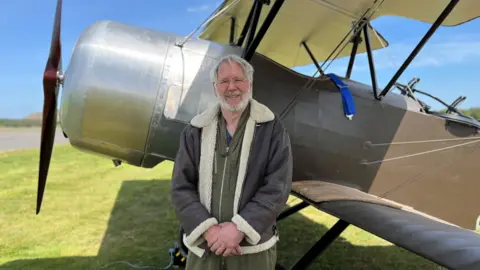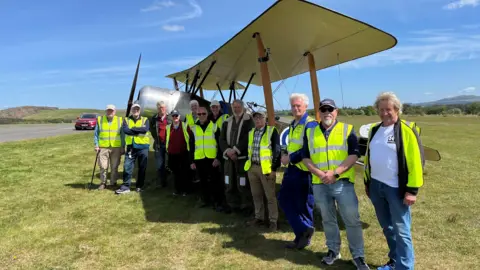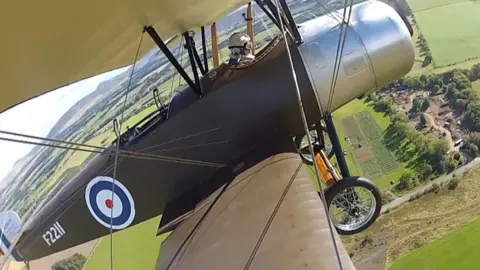World War One replica plane takes off after 25-year labour of love
It has only taken 25 years to get her in the air, but a replica World War One plane built by a group of volunteers in East Lothian is finally flying.
The team behind it started the ambitious project from scratch in 2000, meeting up almost every week to work on the Sopwith Strutter - which they affectionately call Sophie.
After years of painstaking work, Sophie is now undertaking a series of test flights.
Once she is cleared, she will be able to carry passengers.
It's one of these test flights that brings us to RAF Kirknewton, in West Lothian, on a sunny May morning.

Sophie's engine is warming up and her propellers start to turn as she prepares for take off.
There's no hiding the delight in the faces of the team who have put years of work into finally getting her off the ground
The ambitious project by the Aviation Preservation Society of Scotland was not something that could be rushed, according to chairman Mike Harper.

He said: "Every single nut and bolt has been checked, every single bracket has been checked, every single piece of wire has been checked. You don't cobble these things together.
"When you're going to fly it, it has to be done right. If it was for a museum, if it was just going on display we would probably have finished it within a few years.
"But the meticulous attention to detail to get this thing in the air is what's taken the length of time. Who can say they've achieved this sort of thing, a bunch of guys who've retired?"

The team - whose oldest members are in their 80s - have followed the exact plans of the original Sopwith 1 1/2 Strutter - which came into service in 1916. The plane was involved in protecting the Forth coastline in World War One.
Recreating the Strutter involved using the talents of many people, including relative newcomer Donald Gardner.
"It's a fantastic bunch of people, with a huge range of skills from craft skills to engineering skills," he said.
"It's kind of humbling seeing the results of all the work everybody's put into it over, I guess, a generation. Also it's a bit sad that in the back cockpit there's a plaque to all the people that were involved at the start that haven't unfortunately been here at the end. That's quite humbling."
Even on a sunny day, the team has to be very careful about the conditions, especially the wind.
Aircraft inspector Tim Rayner is also the solo pilot and these test flights are allowing him to get used to the feel of the aircraft and how she reacts in certain weather.
He finds a decent window for take-off and the plane leaves the ground.
The flight lasts about 15 minutes and afterwards Tim - who has been involved in the project since the start - gives his verdict on how it went.
"This is the icing on the cake. I'm used to flying modern aeroplanes from the 50's and 60's - the classics - and they're very different from this aeroplane to fly. This is very much more of a challenge.
"The controls are nowhere near as responsive as they became as we developed better technologies. This is 1915 and it's not that many years since the first flight so you've got to look at it as flying as you would expect for an aircraft of that era."
The plane has a passenger seat, but isn't allowed to take two people until passing this testing phase - and completing five hours of flying.
Colin Murray has helped her to prepare for these flights and he is excited about getting a shot in her himself.
"There's a backseat there and currently we're looking at putting some instruments in there, so that when you're flying along you can see what's going on. I don't think I'll be flying in it any time soon because there's quite a queue of, shall we say, older gentlemen in the club who've got first dibs at that.
"But hopefully one I'll sit in the back seat and have a shot."
The test flights allow them to make any necessary tweaks. But the team are very keen to show her off, and if they get enough testing time they hope to take her to air shows before too long.
